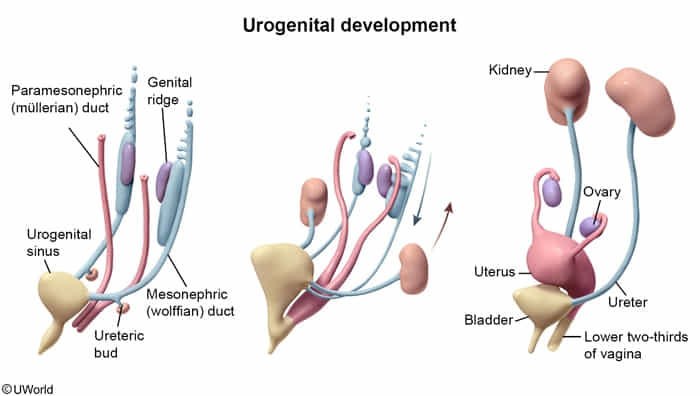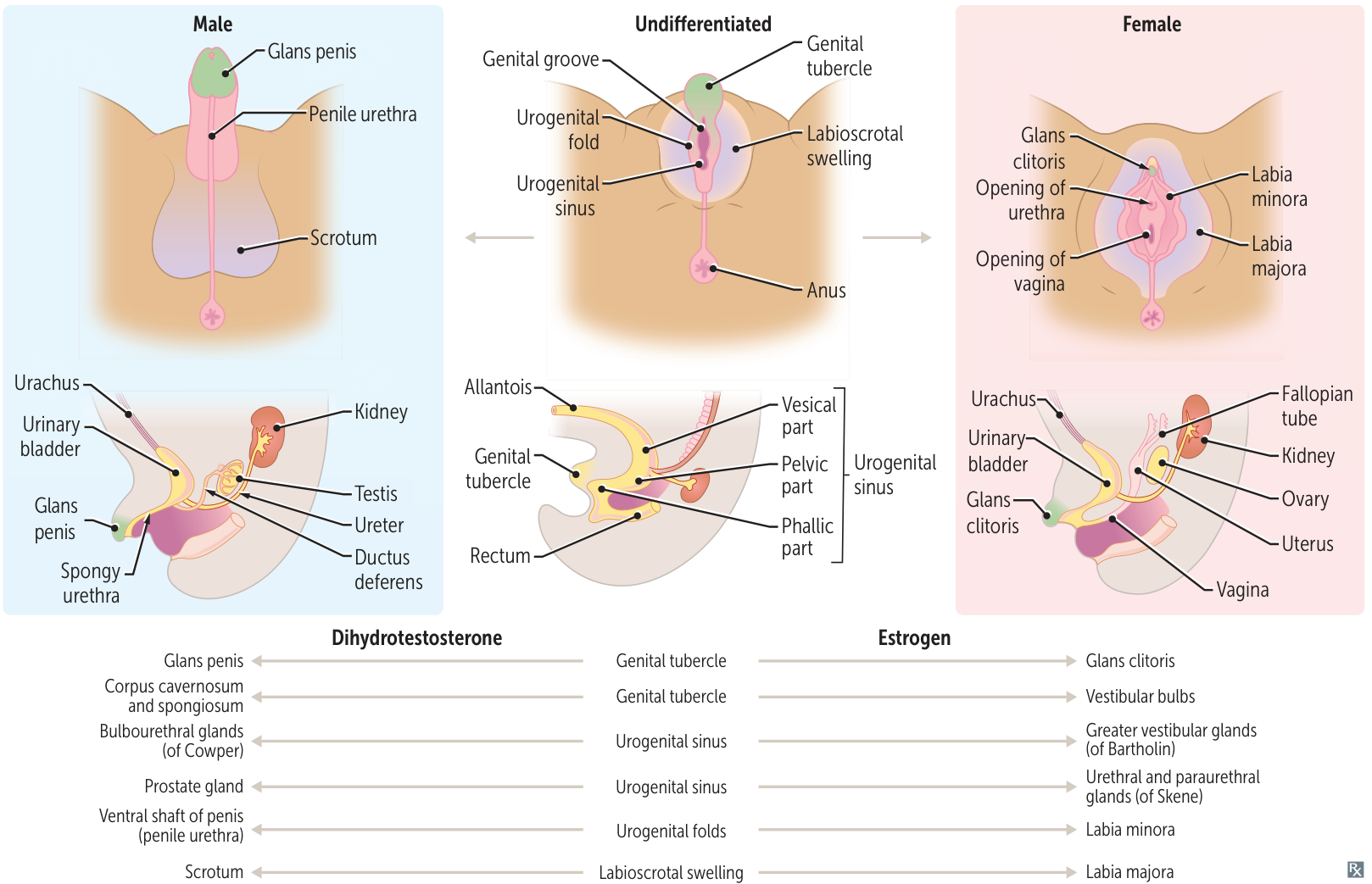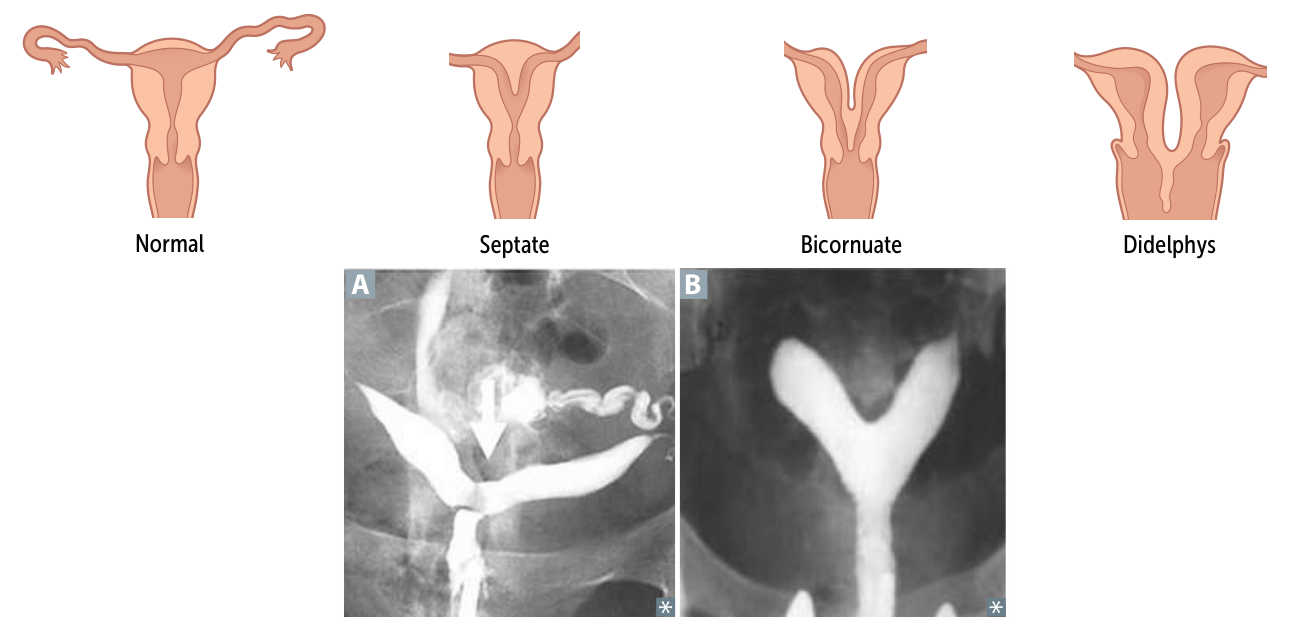Ductal sex differentiation

- Mesonephric (Wolffian) duct → male internal structures
- Paramesonephric (Müllerian) duct → female internal structures
- Ureteric bud (from mesonephric duct) → ureter (in both genders)
Phases

1. Genetic & Gonadal Differentiation (Weeks 1-7)
- Indifferent Stage (until ~wk 7): Embryo has both mesonephric (Wolffian) and paramesonephric (Müllerian) ducts. Gonads are bipotential.
- Genetic Sex is determined at fertilization (XX or XY).
2. Male Development
- Key Driver: SRY gene on Y chromosome encodes for Testis-Determining Factor (TDF).
- TDF → Primitive gonads develop into testes.
- Testicular cells differentiate:
- Sertoli cells: Produce Müllerian Inhibitory Substance (MIS), also known as Anti-Müllerian Hormone (AMH).
- Function: Causes involution/degeneration of the paramesonephric (Müllerian) ducts.
- Absence of MIS → female internal structures develop.
- Leydig cells: Secrete testosterone.
- Function: Stimulates development of the mesonephric (Wolffian) ducts into male internal structures: Seminal vesicles, Epididymis, Ejaculatory duct, Ductus deferens (SEED).
- Sertoli cells: Produce Müllerian Inhibitory Substance (MIS), also known as Anti-Müllerian Hormone (AMH).
- External Genitalia: Testosterone is converted to dihydrotestosterone (DHT) by 5α-reductase. DHT is responsible for the development of male external genitalia (penis, scrotum) and prostate.
3. Female Development
- Key Driver: Absence of the SRY gene. Considered the “default” pathway.
- Gonads: Primitive gonads develop into ovaries.
- Ductal System:
- No MIS/AMH from Sertoli cells → Paramesonephric (Müllerian) ducts persist and develop into female internal structures: Fallopian tubes, uterus, cervix, and upper 1/3 of the vagina.
- No testosterone from Leydig cells → Mesonephric (Wolffian) ducts degenerate.
- External Genitalia: Develop in the absence of DHT. The genital tubercle becomes the clitoris, urethral folds become the labia minora, and labioscrotal swellings become the labia majora.
4. Summary of Homologous Structures
| Indifferent Structure | Male Derivative (stimulated by Androgens) | Female Derivative (default) |
|---|---|---|
| Gonad | Testis | Ovary |
| Genital Tubercle | Glans penis, Corpus cavernosum/spongiosum | Glans clitoris, Vestibular bulbs |
| Urogenital Sinus | Bladder, Urethra, Prostate, Bulbourethral glands | Bladder, Urethra, Lower 2/3 of vagina, Bartholin glands |
| Urogenital Folds | Ventral shaft of penis (penile urethra) | Labia minora |
| Labioscrotal Swellings | Scrotum | Labia majora |
| Gubernaculum | Anchors testes to scrotum | Ovarian ligament, Round ligament of uterus |
External genitalia and urogenital differentiation

Uterine (Müllerian duct) anomalies
- General Impact
- ↓ fertility and ↑ risk of complicated pregnancy (eg, spontaneous abortion, prematurity, Fetal Growth Restriction (FGR), malpresentation).
- Diagnosis
- Hysterosalpingogram (HSG) can demonstrate uterine cavity shape and confirms tubal patency (via intraperitoneal spill of contrast).
- MRI is often the best imaging modality to differentiate specific anomalies.
Specific Anomalies

-
Septate uterus
- Patho: Incomplete resorption of the median septum after fusion of the Müllerian ducts.
- Notes: Most common Müllerian anomaly. Associated with the highest risk of miscarriage.
- Tx: Hysteroscopic septoplasty.
-
Bicornuate uterus
- Patho: Incomplete fusion of the Müllerian ducts.
- Notes: Results in a heart-shaped uterus with two horns.
-
Uterus didelphys
- Patho: Complete failure of Müllerian duct fusion.
- Notes: Results in a double uterus, double cervix, and often a double vagina.